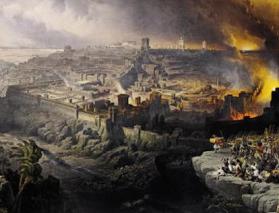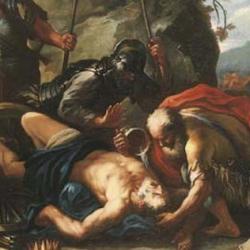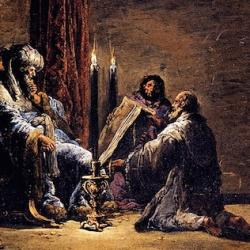1 Chronicles doesn’t say anything about David’s sin against Bath-Sheba and Uriah (cf. 2 Samuel 11–12). Bath-Sheba is never mentioned in Chronicles at all, Uriah only once, in a list of David’s warriors (1 Chronicles 11:41).
In the Chronicler’s account, David’s great sin is taking a census of Israel (1 Chronicles 21; cf. 2 Samuel 24). It’s inspired by Satan (1 Chronicles 21:1), provokes the Lord’s displeasure (v. 7), and leads to a plague that kills 70,000 (vv. 13–14). Clearly, the Chronicler considers is a great evil. But why?
William Johnstone (1 & 2 Chronicles, 1.228–9) points out that David’s census is a military act, a mustering of troops, but done without following the procedures laid out in Exodus 30, where Yahweh requires each man who is mustered to give a half-shekel “ransom” to “make atonement” before going to war.
Johnstone explains the logic: “The Israelite males from twenty and upward are registered for military service. War is not being glorified: military service is only legitimate within the context of fighting the LORD’s battles as the LORD’s host. Killing on the field of battle is an inevitable consequence of war: but taking the life of another human being immediately warrants the payment of life for life.” Exodus 30 provides the “necessary sacral preparation for war,” the half-shekel serving as “the indemnity laid up as a perpetual reminder before the LORD for the life of ‘you all,’ that is, not just of the combatants, but of the community at large, on whose behalf the host sallies forth and which might suffer because of the blood shed by the host.”
The half-shekel atones, that is, it maintains “the oneness between community and God, which will otherwise be broken even by acts of necessary bloodshed.” The atonement is not repair but prophylactic, a set of “precautionary, prospective measures, which anticipate the possibility of bloodshed.”
David doesn’t prepare the troops in this way, just as he did not observe the protocols for the transfer of the ark (1 Chronicles 13), a failure that also had disastrous consequences. It’s as if David tried to enter the sanctuary without the protective veils that screen human beings from the holy God. By ignoring the half-shekel atonement, David also bypasses the Levites, who are normally essential to the conduct of war. Having foregone the prophylactic atonement, David has to prepare a retrospective atonement, which repairs Israel’s relation to Yahweh.
All that is true, but there are a couple of other dimensions to David’s sin. Judgment by the mashit, the death-angel, is a clue. The mashit appears in Exodus 12:13, 23, slaughtering the firstborn of Egypt in retribution for Pharaoh’s enslavement of Yahweh’s son Israel. Now the death-angel is back, slaughtering Israelites. The typology assigns David the role of Pharaoh, seizing God’s people for his own purposes. He has turned Israel back into an Egypt, in need of a Passover sacrifice to stay the plague. The typology cuts even deeper, because David is also an Adam, seizing forbidden fruit, seizing God’s host. The census is a sacrilege, an intrusion on Yahweh’s realm.
The Chronicler doesn’t whitewash David’s reign. The census is, by ancient Israelite standards, as great a sin as adultery and murder, because it is a direct and flagrant trespass onto Yahweh’s rights. Indeed, it appears to be a variation of his sin with Bath-Sheba, on a national scale: In 2 Samuel, David seized the wife of one of his warrior; in 1 Chronicles, David seizes the host of Yahweh, and treats it as if it were his own.
With Bath-Sheba, David committed statutory if not actual rape. The census is worse: He rapes the bride of Yahweh.











